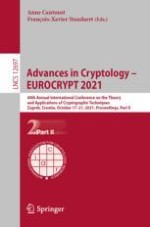2021 | OriginalPaper | Buchkapitel
VOLE-PSI: Fast OPRF and Circuit-PSI from Vector-OLE
verfasst von : Peter Rindal, Phillipp Schoppmann
Erschienen in: Advances in Cryptology – EUROCRYPT 2021
Aktivieren Sie unsere intelligente Suche, um passende Fachinhalte oder Patente zu finden.
Wählen Sie Textabschnitte aus um mit Künstlicher Intelligenz passenden Patente zu finden. powered by
Markieren Sie Textabschnitte, um KI-gestützt weitere passende Inhalte zu finden. powered by
